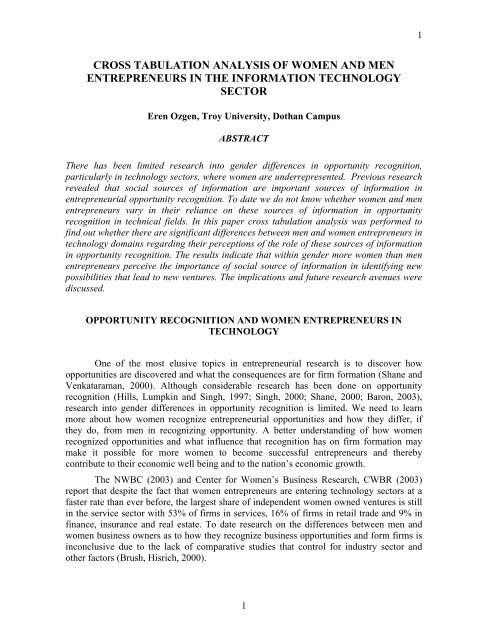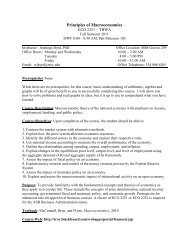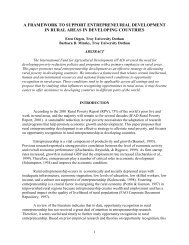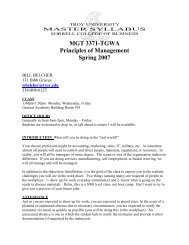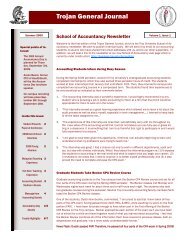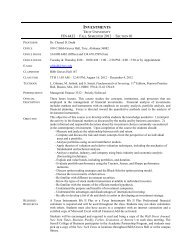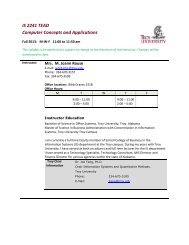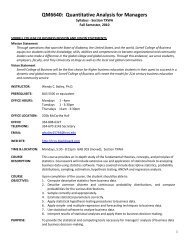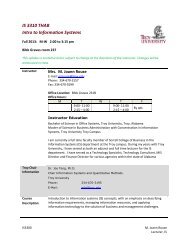cross tabulation analysis of women and men entrepreneurs in the
cross tabulation analysis of women and men entrepreneurs in the
cross tabulation analysis of women and men entrepreneurs in the
- No tags were found...
You also want an ePaper? Increase the reach of your titles
YUMPU automatically turns print PDFs into web optimized ePapers that Google loves.
1CROSS TABULATION ANALYSIS OF WOMEN AND MENENTREPRENEURS IN THE INFORMATION TECHNOLOGYSECTOREren Ozgen, Troy University, Dothan CampusABSTRACTThere has been limited research <strong>in</strong>to gender differences <strong>in</strong> opportunity recognition,particularly <strong>in</strong> technology sectors, where <strong>wo<strong>men</strong></strong> are underrepresented. Previous researchrevealed that social sources <strong>of</strong> <strong>in</strong>formation are important sources <strong>of</strong> <strong>in</strong>formation <strong>in</strong>entrepreneurial opportunity recognition. To date we do not know whe<strong>the</strong>r <strong>wo<strong>men</strong></strong> <strong>and</strong> <strong>men</strong><strong>entrepreneurs</strong> vary <strong>in</strong> <strong>the</strong>ir reliance on <strong>the</strong>se sources <strong>of</strong> <strong>in</strong>formation <strong>in</strong> opportunityrecognition <strong>in</strong> technical fields. In this paper <strong>cross</strong> <strong>tabulation</strong> <strong>analysis</strong> was performed t<strong>of</strong><strong>in</strong>d out whe<strong>the</strong>r <strong>the</strong>re are significant differences between <strong>men</strong> <strong>and</strong> <strong>wo<strong>men</strong></strong> <strong>entrepreneurs</strong> <strong>in</strong>technology doma<strong>in</strong>s regard<strong>in</strong>g <strong>the</strong>ir perceptions <strong>of</strong> <strong>the</strong> role <strong>of</strong> <strong>the</strong>se sources <strong>of</strong> <strong>in</strong>formation<strong>in</strong> opportunity recognition. The results <strong>in</strong>dicate that with<strong>in</strong> gender more <strong>wo<strong>men</strong></strong> than <strong>men</strong><strong>entrepreneurs</strong> perceive <strong>the</strong> importance <strong>of</strong> social source <strong>of</strong> <strong>in</strong>formation <strong>in</strong> identify<strong>in</strong>g newpossibilities that lead to new ventures. The implications <strong>and</strong> future research avenues werediscussed.OPPORTUNITY RECOGNIITION AND WOMEN ENTREPRENEURS INTECHNOLOGYOne <strong>of</strong> <strong>the</strong> most elusive topics <strong>in</strong> entrepreneurial research is to discover howopportunities are discovered <strong>and</strong> what <strong>the</strong> consequences are for firm formation (Shane <strong>and</strong>Venkataraman, 2000). Although considerable research has been done on opportunityrecognition (Hills, Lumpk<strong>in</strong> <strong>and</strong> S<strong>in</strong>gh, 1997; S<strong>in</strong>gh, 2000; Shane, 2000; Baron, 2003),research <strong>in</strong>to gender differences <strong>in</strong> opportunity recognition is limited. We need to learnmore about how <strong>wo<strong>men</strong></strong> recognize entrepreneurial opportunities <strong>and</strong> how <strong>the</strong>y differ, if<strong>the</strong>y do, from <strong>men</strong> <strong>in</strong> recogniz<strong>in</strong>g opportunity. A better underst<strong>and</strong><strong>in</strong>g <strong>of</strong> how <strong>wo<strong>men</strong></strong>recognized opportunities <strong>and</strong> what <strong>in</strong>fluence that recognition has on firm formation maymake it possible for more <strong>wo<strong>men</strong></strong> to become successful <strong>entrepreneurs</strong> <strong>and</strong> <strong>the</strong>rebycontribute to <strong>the</strong>ir economic well be<strong>in</strong>g <strong>and</strong> to <strong>the</strong> nation’s economic growth.The NWBC (2003) <strong>and</strong> Center for Wo<strong>men</strong>’s Bus<strong>in</strong>ess Research, CWBR (2003)report that despite <strong>the</strong> fact that <strong>wo<strong>men</strong></strong> <strong>entrepreneurs</strong> are enter<strong>in</strong>g technology sectors at afaster rate than ever before, <strong>the</strong> largest share <strong>of</strong> <strong>in</strong>dependent <strong>wo<strong>men</strong></strong> owned ventures is still<strong>in</strong> <strong>the</strong> service sector with 53% <strong>of</strong> firms <strong>in</strong> services, 16% <strong>of</strong> firms <strong>in</strong> retail trade <strong>and</strong> 9% <strong>in</strong>f<strong>in</strong>ance, <strong>in</strong>surance <strong>and</strong> real estate. To date research on <strong>the</strong> differences between <strong>men</strong> <strong>and</strong><strong>wo<strong>men</strong></strong> bus<strong>in</strong>ess owners as to how <strong>the</strong>y recognize bus<strong>in</strong>ess opportunities <strong>and</strong> form firms is<strong>in</strong>conclusive due to <strong>the</strong> lack <strong>of</strong> comparative studies that control for <strong>in</strong>dustry sector <strong>and</strong>o<strong>the</strong>r factors (Brush, Hisrich, 2000).1
2SOCIAL SOURCES OF INFORMATION IN OPPORTUNITY RECOGNITIONAn extensive body <strong>of</strong> research on opportunity recognition <strong>in</strong>dicates that socialsources <strong>of</strong> <strong>in</strong>formation constitute an essential part <strong>of</strong> opportunity recognition (Aldrich,1999; Hills, Lumpk<strong>in</strong> <strong>and</strong> S<strong>in</strong>gh, 1997). Previous studies found that social network ties(Archdivili, Cardozo, & Ray, 2002) such as <strong>in</strong>formal network <strong>of</strong> acqua<strong>in</strong>tances (Floyd <strong>and</strong>Wooldridge, 1999), reliance on <strong>men</strong>tors (Ozgen <strong>and</strong> Baron, 2007), participation <strong>in</strong>pr<strong>of</strong>essional forums (Ozgen <strong>and</strong> Baron, 2007) are important social sources <strong>of</strong> <strong>in</strong>formation<strong>and</strong> play a role <strong>in</strong> opportunity recognition. This study will exp<strong>and</strong> prior studies <strong>and</strong> fur<strong>the</strong>rexam<strong>in</strong>e whe<strong>the</strong>r <strong>the</strong>re are significant differences between <strong>men</strong> <strong>and</strong> <strong>wo<strong>men</strong></strong> <strong>entrepreneurs</strong><strong>in</strong> technology doma<strong>in</strong>s regard<strong>in</strong>g <strong>the</strong>ir perceptions <strong>of</strong> <strong>the</strong> role <strong>of</strong> <strong>the</strong>se sources <strong>of</strong><strong>in</strong>formation <strong>in</strong> opportunity recognition. From a conceptual st<strong>and</strong>po<strong>in</strong>t, to be able to answer<strong>the</strong> question “how do people discover opportunities?” it may be useful to consider genderdifferences regard<strong>in</strong>g <strong>the</strong> role <strong>of</strong> various social factors <strong>in</strong> <strong>the</strong> recognition <strong>of</strong> opportunities. Itwas reasoned that by exam<strong>in</strong><strong>in</strong>g gender differences <strong>in</strong> opportunity recognition, we mightget a clearer underst<strong>and</strong><strong>in</strong>g <strong>of</strong> one <strong>of</strong> <strong>the</strong> pr<strong>in</strong>cipal activities <strong>in</strong> company formation.Gender differences <strong>in</strong> <strong>in</strong>formal network <strong>of</strong> acqua<strong>in</strong>tances <strong>in</strong> <strong>the</strong> <strong>in</strong>dustryInformal network <strong>of</strong> acqua<strong>in</strong>tances <strong>in</strong> <strong>the</strong> <strong>in</strong>dustry, such as customers, clients,manufacturers, suppliers, <strong>in</strong>vestors <strong>and</strong> employees <strong>of</strong> f<strong>in</strong>ancial <strong>in</strong>stitutions, allow<strong>entrepreneurs</strong> to enlarge <strong>the</strong>ir knowledge <strong>of</strong> opportunities <strong>and</strong> to ga<strong>in</strong> knowledge (Floyd<strong>and</strong> Wooldridge, 1999). Prior research found <strong>the</strong> importance <strong>of</strong> <strong>in</strong>formal network <strong>in</strong>identify<strong>in</strong>g new venture ideas <strong>and</strong> recogniz<strong>in</strong>g <strong>and</strong> screen<strong>in</strong>g possible venture opportunities(Hills, et. al, 1997; S<strong>in</strong>gh, 2000). Social capital <strong>the</strong>ory suggests that network ties providepotential or possibilities <strong>of</strong> access to resources <strong>and</strong> knowledge that is critical toentrepreneurial pursuits. Entrepreneurial activities may be sourced <strong>in</strong> <strong>the</strong> knowledge <strong>of</strong><strong>in</strong>dustry or know<strong>in</strong>g someone who knows <strong>the</strong> <strong>in</strong>dustry (McMullan <strong>and</strong> Long, 1990).Prior empirical research suggested that <strong>wo<strong>men</strong></strong> bus<strong>in</strong>ess owners have less executiveexperience <strong>and</strong> have fewer f<strong>in</strong>ancial assets than <strong>the</strong>ir male counterparts when <strong>the</strong>y start upnew ventures (Carter <strong>and</strong> Allan, 1997). Peacock (2001) reported that, accord<strong>in</strong>g to <strong>the</strong>NFWBO survey <strong>wo<strong>men</strong></strong> bus<strong>in</strong>ess owners (23%) have less managerial experience than <strong>men</strong>bus<strong>in</strong>ess owners (50%). In <strong>the</strong> U.S., <strong>men</strong> hold three quarters <strong>of</strong> executive <strong>and</strong> managerialpositions <strong>in</strong> Information Technology (Hopk<strong>in</strong>s, 2003). To compensate for this lack <strong>of</strong>managerial <strong>and</strong> executive experience successful <strong>wo<strong>men</strong></strong> bus<strong>in</strong>ess owners (60%) consultwith outside sources <strong>of</strong> <strong>in</strong>formation more than <strong>the</strong>ir male counterparts (44%) (Schatz,2001). Moreover, accord<strong>in</strong>g to CWBR (2003), 60% <strong>of</strong> <strong>wo<strong>men</strong></strong> bus<strong>in</strong>ess owners <strong>in</strong>technology sector use social network ties <strong>in</strong> technology sector compared to 40% <strong>of</strong> <strong>wo<strong>men</strong></strong>bus<strong>in</strong>ess owners <strong>in</strong> o<strong>the</strong>r sectors on bus<strong>in</strong>ess manage<strong>men</strong>t <strong>and</strong> growth issues. Therefore,<strong>wo<strong>men</strong></strong> who move <strong>in</strong>to technology sectors may need to develop a bus<strong>in</strong>ess support networkthat helps <strong>the</strong>m <strong>in</strong> <strong>the</strong> exploitation <strong>of</strong> opportunities. This suggests <strong>the</strong> follow<strong>in</strong>g hypo<strong>the</strong>sis:2
3Hypo<strong>the</strong>sis #1: Wo<strong>men</strong> <strong>entrepreneurs</strong> <strong>in</strong> technology doma<strong>in</strong>s perceive <strong>the</strong> <strong>in</strong>fluence<strong>of</strong> <strong>in</strong>formal network <strong>of</strong> acqua<strong>in</strong>tances <strong>in</strong> <strong>the</strong> <strong>in</strong>dustry more than <strong>men</strong> <strong>entrepreneurs</strong><strong>in</strong> <strong>the</strong>ir recognition <strong>of</strong> entrepreneurial opportunities.Gender differences <strong>in</strong> reliance on <strong>men</strong>torsMentors refer to people who take an active role <strong>in</strong> help<strong>in</strong>g <strong>the</strong>ir protégés <strong>and</strong> guide<strong>the</strong>m technically <strong>and</strong> pr<strong>of</strong>essionally by provid<strong>in</strong>g advice, guidance, knowledge <strong>and</strong>coach<strong>in</strong>g (Boyd <strong>and</strong> Vozitis, 1994). Mentors can provide “multiple perspectives” <strong>in</strong> one’sentrepreneurial pursuits (Kuratko <strong>and</strong> Welsch, 2001: 180) <strong>and</strong> help <strong>the</strong>ir protégés <strong>in</strong><strong>in</strong>creas<strong>in</strong>g <strong>in</strong>novation <strong>and</strong> creativity (Rag<strong>in</strong>s <strong>and</strong> Cotton, 1993). Researchers found thatmost successful <strong>entrepreneurs</strong> have or had a <strong>men</strong>tor<strong>in</strong>g relationship (Cachon <strong>and</strong> Cotton,1997). Here <strong>in</strong> this paper we suggest <strong>men</strong>tors would <strong>in</strong>clude, among o<strong>the</strong>rs, current or pastcustomers, current or past suppliers, employees <strong>of</strong> f<strong>in</strong>ancial <strong>in</strong>stitutions, <strong>and</strong> o<strong>the</strong>rs.Previous research suggests that <strong>the</strong> broader <strong>entrepreneurs</strong>’ <strong>in</strong>formal networks, <strong>the</strong> morelikely <strong>the</strong>y are to ga<strong>the</strong>r relevant <strong>in</strong>formation (e.g., Johansson, 2000).Prior researchers have shown that <strong>wo<strong>men</strong></strong> <strong>entrepreneurs</strong> use more external bus<strong>in</strong>esssupport, such as advice, guidance <strong>and</strong> coach<strong>in</strong>g, compared to <strong>men</strong> <strong>entrepreneurs</strong> (Mitchell<strong>and</strong> Weller, 2001). For <strong>in</strong>stance, accord<strong>in</strong>g to NFWBO (1998) study, 46% <strong>of</strong> <strong>wo<strong>men</strong></strong><strong>entrepreneurs</strong> versus 37% <strong>of</strong> <strong>men</strong> <strong>entrepreneurs</strong> reported <strong>the</strong> role <strong>of</strong> hav<strong>in</strong>g a <strong>men</strong>tor or rolemodel <strong>in</strong> <strong>the</strong>ir entrepreneurial pursuits. In a similar ve<strong>in</strong>, previous studies identified somecritical factors, such as less bus<strong>in</strong>ess experience, may affect <strong>wo<strong>men</strong></strong>’s tendency to pursueentrepreneurial activities (Chell, 2002; Mitchell <strong>and</strong> Weller, 2001). Thus, grounded <strong>in</strong> priorempirical research, we assume that <strong>wo<strong>men</strong></strong> <strong>entrepreneurs</strong> may show more will<strong>in</strong>gness than<strong>men</strong> to seek bus<strong>in</strong>ess guidance, advice <strong>and</strong> coach<strong>in</strong>g from <strong>men</strong>tors <strong>and</strong> this may be tocompensate for <strong>the</strong>ir lack <strong>of</strong> access to knowledge <strong>and</strong> positions that put <strong>the</strong>m <strong>in</strong> <strong>the</strong> heart <strong>of</strong><strong>the</strong> action about new technologies <strong>and</strong> opportunities. This leads <strong>the</strong> follow<strong>in</strong>g hypo<strong>the</strong>sis:Hypo<strong>the</strong>sis #2: Wo<strong>men</strong> <strong>entrepreneurs</strong> <strong>in</strong> technology doma<strong>in</strong>s perceive <strong>the</strong> <strong>in</strong>fluence<strong>of</strong> exposure to <strong>men</strong>tors more than <strong>men</strong> <strong>entrepreneurs</strong> <strong>in</strong> <strong>the</strong>ir recognition <strong>of</strong>entrepreneurial opportunities.Gender differences <strong>in</strong> participation <strong>in</strong> pr<strong>of</strong>essional forumsExposure to <strong>in</strong>formation com<strong>in</strong>g from various sources leads to creativity,<strong>in</strong>novation <strong>and</strong> new knowledge <strong>and</strong> is found significantly related to opportunity recognition(Julien <strong>and</strong> Vaghely, 2001). The frequency <strong>and</strong> <strong>in</strong>tensity <strong>of</strong> exchanged <strong>in</strong>formation is atrigger <strong>in</strong> form<strong>in</strong>g new ideas regard<strong>in</strong>g with new venture possibilities (Fiet, 1996).Entrepreneurs also seek <strong>in</strong>formation about develop<strong>men</strong>ts <strong>in</strong> <strong>the</strong>ir field through more formalchannels than <strong>the</strong>ir <strong>in</strong>dustry networks (e.g., Bhave, 1994). For <strong>the</strong> purposes <strong>of</strong> this study wewill refer participation <strong>of</strong> pr<strong>of</strong>essional forums as communication com<strong>in</strong>g from variousformal sources such as, technical publications, journals, workshops, sem<strong>in</strong>ars, conferences<strong>and</strong> tra<strong>in</strong><strong>in</strong>g programs.3
4Accord<strong>in</strong>g to NFWBO’s (1998) research, 85% <strong>of</strong> <strong>wo<strong>men</strong></strong> give greater importance totra<strong>in</strong><strong>in</strong>g <strong>in</strong> bus<strong>in</strong>ess related issues compared to 78% <strong>men</strong>. Therefore, <strong>wo<strong>men</strong></strong> <strong>entrepreneurs</strong><strong>in</strong> technical fields may consider participation <strong>in</strong> pr<strong>of</strong>essional forums as an importantele<strong>men</strong>t <strong>in</strong> <strong>the</strong>ir entrepreneurial pursuits <strong>and</strong> recognition <strong>of</strong> opportunities more than <strong>men</strong> <strong>in</strong>order to compensate for <strong>the</strong> weaknesses com<strong>in</strong>g from <strong>the</strong>ir lack <strong>of</strong> technical or bus<strong>in</strong>esstra<strong>in</strong><strong>in</strong>g. This suggests <strong>the</strong> next hypo<strong>the</strong>sis:Hypo<strong>the</strong>sis #3: Wo<strong>men</strong> <strong>entrepreneurs</strong> <strong>in</strong> technology doma<strong>in</strong>s perceive <strong>the</strong> <strong>in</strong>fluence<strong>of</strong> participation <strong>in</strong> pr<strong>of</strong>essional forums more than <strong>men</strong> <strong>entrepreneurs</strong> <strong>in</strong> <strong>the</strong>irrecognition <strong>of</strong> entrepreneurial opportunities.Figure 1 presents an overview <strong>of</strong> <strong>the</strong> conceptual framework.FIGURE 1A model <strong>of</strong> gender difference <strong>in</strong> entrepreneurial opportunity recognitionReliance on <strong>in</strong>formalNetwork ties <strong>in</strong> <strong>the</strong><strong>in</strong>dustryGenderOpportunityRecognitionReliance onMentorsParticipation <strong>in</strong>pr<strong>of</strong>essionalforumsMETHODSSampleA sample was chosen from <strong>the</strong> <strong>in</strong>formation technology <strong>in</strong>dustry. Potentialparticipants were identified from <strong>the</strong> One Source Corp Tech Pr<strong>of</strong>iles Database (OSCT,2002), which conta<strong>in</strong>s <strong>in</strong>formation on technology-based firms <strong>and</strong> from membership lists<strong>of</strong> various IT associations. The <strong>in</strong>itial questionnaire was pilot tested on 29 founders <strong>of</strong> newventures <strong>in</strong> <strong>the</strong> <strong>in</strong>formation technology sector. The f<strong>in</strong>al sample constituted 201 <strong>in</strong>dividualswho founded <strong>in</strong>formation technology companies <strong>in</strong> <strong>the</strong> United States.4
5MEASURESOpportunity RecognitionThe five po<strong>in</strong>t three item “opportunity recognition” scale from S<strong>in</strong>gh (2000).Measures were: “I see potential new venture ideas all around me.” “I have special alertnessor sensitivity toward new venture opportunities.” “Recogniz<strong>in</strong>g opportunities come verynatural to me”. (alpha=.8)Informal network <strong>of</strong> acqua<strong>in</strong>tances <strong>in</strong> <strong>the</strong> <strong>in</strong>dustryFive po<strong>in</strong>t three item measures were adopted from Reynolds (1999). The measureswere contacts or discussions with potential or exist<strong>in</strong>g customers, <strong>in</strong>vestors, suppliers,distributors or manufacturers. (alpha= .77)MentorsThe present research scale developed <strong>the</strong> three five po<strong>in</strong>t items. The measures werehav<strong>in</strong>g a <strong>men</strong>tor who provides advice, support, guidance, knowledge <strong>and</strong> coach<strong>in</strong>g <strong>in</strong>opportunity recognition. Five po<strong>in</strong>t Likert scale measured <strong>the</strong> variable (alpha=.85)Participation <strong>in</strong> Pr<strong>of</strong>essional ForumsThe present research scale developed <strong>the</strong> three five po<strong>in</strong>t items. The measureswere: gett<strong>in</strong>g <strong>in</strong>formation or feedback from <strong>in</strong>structional sem<strong>in</strong>ars, workshops, tra<strong>in</strong><strong>in</strong>gprograms <strong>and</strong> technical publications. (alpha= .82).Control VariablesIndividuals’ age, education (Davidsson, 1991; Shepherd <strong>and</strong> DeTienne, 2001) <strong>and</strong>firm location (Keeble <strong>and</strong> Walker, 1994; Arm<strong>in</strong>gton <strong>and</strong> Acs, 2002) were <strong>in</strong>cluded ascontrol variables.Cross TabulationRESULTSCross <strong>tabulation</strong> <strong>analysis</strong> was conducted to show <strong>the</strong> relationship between male <strong>and</strong>female <strong>entrepreneurs</strong> <strong>and</strong> how <strong>the</strong>y differ <strong>in</strong> recogniz<strong>in</strong>g entrepreneurial opportunities.Perform<strong>in</strong>g <strong>cross</strong> <strong>tabulation</strong> with cont<strong>in</strong>uous data that has been categorized providevaluable <strong>in</strong>formation on how genders vary <strong>in</strong> entrepreneurial opportunity recognition <strong>in</strong> IT<strong>in</strong>dustry.Although both <strong>men</strong> <strong>and</strong> <strong>wo<strong>men</strong></strong> <strong>entrepreneurs</strong> agreed <strong>the</strong> importance <strong>of</strong> <strong>in</strong>formalnetwork ties <strong>in</strong> <strong>the</strong> <strong>in</strong>dustry, with<strong>in</strong> gender relatively more <strong>wo<strong>men</strong></strong> (63.3%) than <strong>men</strong>5
6(52.9%) perceived <strong>the</strong> importance <strong>of</strong> <strong>in</strong>formal network <strong>of</strong> acqua<strong>in</strong>tances <strong>in</strong> <strong>the</strong> <strong>in</strong>dustry <strong>in</strong>entrepreneurial opportunity recognition. Results supported hypo<strong>the</strong>sis # 1 <strong>in</strong>dicat<strong>in</strong>g that<strong>wo<strong>men</strong></strong> <strong>entrepreneurs</strong> perceive <strong>the</strong> <strong>in</strong>fluence <strong>of</strong> <strong>in</strong>formal network acqua<strong>in</strong>tances <strong>in</strong> <strong>the</strong><strong>in</strong>dustry more than <strong>men</strong> <strong>entrepreneurs</strong> <strong>in</strong> <strong>the</strong>ir recognition <strong>of</strong> opportunities. CrossTabulation results were significant (p
7Yet despite <strong>the</strong>se limitations <strong>the</strong> f<strong>in</strong>d<strong>in</strong>gs <strong>of</strong>fer several practical <strong>and</strong> <strong>the</strong>oreticalcontributions to <strong>the</strong> opportunity recognition research.Practical ImplicationsThe results <strong>in</strong>dicate that a great deal <strong>of</strong> <strong>wo<strong>men</strong></strong>’s entrepreneurial opportunityrecognition <strong>in</strong> technology sectors may be spread through social messages <strong>in</strong> network ties<strong>and</strong> participation <strong>in</strong> pr<strong>of</strong>essional forums, (tra<strong>in</strong><strong>in</strong>g programs, etc.) compared to <strong>men</strong><strong>entrepreneurs</strong>. Thus, <strong>in</strong> <strong>the</strong> short <strong>and</strong> medium terms, it may be necessary to encourage<strong>wo<strong>men</strong></strong> <strong>in</strong> technology to jo<strong>in</strong> various <strong>in</strong>dustry associations, attend <strong>in</strong>dustrial workshops,read technical publications <strong>and</strong> develop social network ties <strong>and</strong> f<strong>in</strong>d <strong>men</strong>tors. For <strong>in</strong>stance,<strong>men</strong>tor<strong>in</strong>g programs <strong>in</strong> which successful <strong>entrepreneurs</strong> work with potential <strong>wo<strong>men</strong></strong><strong>entrepreneurs</strong> could help <strong>in</strong> recogniz<strong>in</strong>g potential entrepreneurial opportunities. Jo<strong>in</strong><strong>in</strong>g <strong>in</strong>programs that facilitate peer <strong>in</strong>teraction may also assist <strong>wo<strong>men</strong></strong> <strong>in</strong> develop<strong>in</strong>g network<strong>in</strong>g<strong>and</strong> opportunity recognition skills. Programs that <strong>in</strong>clude <strong>the</strong> match up <strong>of</strong> <strong>men</strong>tors with <strong>the</strong>participants may provide on-go<strong>in</strong>g support to potential <strong>wo<strong>men</strong></strong> <strong>entrepreneurs</strong> <strong>in</strong> network<strong>in</strong>gskills <strong>and</strong> assist<strong>in</strong>g <strong>the</strong>m <strong>in</strong> identify<strong>in</strong>g <strong>and</strong> f<strong>in</strong>d<strong>in</strong>g various resources that would help <strong>the</strong>mto recognize opportunities.The f<strong>in</strong>d<strong>in</strong>gs may help to empower potential <strong>wo<strong>men</strong></strong> <strong>entrepreneurs</strong> <strong>in</strong> <strong>the</strong>ir access toresources that lead <strong>the</strong>m to <strong>the</strong> recognition <strong>of</strong> opportunities. Symposia, conferences <strong>and</strong>events that <strong>of</strong>fer potential <strong>wo<strong>men</strong></strong> <strong>entrepreneurs</strong> an opportunity to meet with o<strong>the</strong>r<strong>entrepreneurs</strong> <strong>in</strong> technology sectors may also be helpful. The f<strong>in</strong>d<strong>in</strong>gs support <strong>the</strong>develop<strong>men</strong>t <strong>of</strong> enabl<strong>in</strong>g resources, which will allow <strong>wo<strong>men</strong></strong> to ga<strong>in</strong> access to knowledgeparticularly <strong>in</strong> recogniz<strong>in</strong>g opportunities that would help empower <strong>the</strong>m <strong>in</strong> <strong>the</strong>irentrepreneurial pursuits.Theoretical ImplicationsThe primary contribution <strong>of</strong> this study lies <strong>in</strong> <strong>the</strong> knowledge <strong>of</strong> <strong>the</strong> differentialpatterns between <strong>men</strong> <strong>and</strong> <strong>wo<strong>men</strong></strong> <strong>entrepreneurs</strong> regard<strong>in</strong>g <strong>the</strong>ir perception <strong>of</strong> <strong>the</strong> role <strong>of</strong><strong>in</strong>formal network ties, exposure to <strong>men</strong>tors <strong>and</strong> participation <strong>in</strong> pr<strong>of</strong>essional forums <strong>in</strong>opportunity recognition. From a conceptual st<strong>and</strong>po<strong>in</strong>t, to be able to answer <strong>the</strong> question“how do people discover opportunities?” it may be useful to consider gender differencesregard<strong>in</strong>g <strong>the</strong>ir perception <strong>of</strong> <strong>the</strong> role <strong>of</strong> various social <strong>and</strong> environ<strong>men</strong>tal factors <strong>in</strong> <strong>the</strong>recognition <strong>of</strong> opportunities. Future researchers may use <strong>the</strong> concepts presented here togenerate a robust <strong>the</strong>ory <strong>of</strong> <strong>entrepreneurs</strong>hip.Future avenues <strong>of</strong> researchTechnology markets are complex <strong>in</strong> nature highly <strong>in</strong>tensive <strong>and</strong> exist under rapidlychang<strong>in</strong>g technological conditions. As <strong>the</strong> technical status <strong>of</strong> <strong>the</strong> environ<strong>men</strong>t gets morecomplex <strong>and</strong> harder, <strong>the</strong> <strong>entrepreneurs</strong> need more <strong>in</strong>formation. Therefore, underst<strong>and</strong><strong>in</strong>g<strong>the</strong> process by which new ventures emerge <strong>in</strong> technology doma<strong>in</strong> is clearly one <strong>of</strong> <strong>the</strong> keychallenges for <strong>entrepreneurs</strong>hip researchers. To better teach opportunity recognition to7
8prospective <strong>wo<strong>men</strong></strong> <strong>entrepreneurs</strong> <strong>in</strong> technical sectors, it is necessary to study this processfur<strong>the</strong>r. In <strong>the</strong> future focus<strong>in</strong>g on <strong>wo<strong>men</strong></strong> with technical degrees <strong>and</strong> <strong>the</strong>ir propensity <strong>of</strong>start<strong>in</strong>g new ventures <strong>in</strong> technical fields seems to be a study worthwhile. The NationalScience Foundation (NSF, 2002) reports that <strong>wo<strong>men</strong></strong> granted science <strong>and</strong> eng<strong>in</strong>eer<strong>in</strong>g(S&E) degrees, exclud<strong>in</strong>g social sciences, account for 15% <strong>of</strong> all technical degrees <strong>in</strong> U.S.Accord<strong>in</strong>g to an NSF (2002) report, among <strong>the</strong> total self-employed people with technicaldegrees <strong>in</strong> <strong>the</strong> bus<strong>in</strong>ess sector, <strong>wo<strong>men</strong></strong> are less likely than <strong>men</strong> to be employed <strong>in</strong> technicaldoma<strong>in</strong>s, (35.1% <strong>of</strong> <strong>men</strong> versus 2.9% <strong>of</strong> <strong>wo<strong>men</strong></strong> self employed <strong>in</strong> eng<strong>in</strong>eer<strong>in</strong>g relatedfields) <strong>and</strong> 24.7% <strong>of</strong> <strong>men</strong> versus 12.6% <strong>of</strong> <strong>wo<strong>men</strong></strong> self employed <strong>in</strong> computer/math sciencerelated sectors. Therefore, ano<strong>the</strong>r fur<strong>the</strong>r avenue <strong>of</strong> research may be a comparative study<strong>of</strong> <strong>men</strong> <strong>and</strong> <strong>wo<strong>men</strong></strong> with technical degrees <strong>and</strong> <strong>the</strong> differences between <strong>the</strong>m <strong>in</strong>entrepreneurial opportunity recognition <strong>and</strong> start<strong>in</strong>g new ventures <strong>in</strong> technology. Suchstudy is very timely <strong>and</strong> helpful <strong>in</strong> our underst<strong>and</strong><strong>in</strong>g <strong>the</strong> challenges <strong>wo<strong>men</strong></strong> face with <strong>in</strong>start<strong>in</strong>g new ventures <strong>in</strong> technical fields.8
9REFERENCESAldrich, H.E., Brickman, A.E., <strong>and</strong> Reese, P.R. (1997). Strong-ties, weak-ties <strong>and</strong>Strangers: Do Wo<strong>men</strong> Bus<strong>in</strong>ess Owners Differ from Men <strong>in</strong> Their Use <strong>of</strong> Network<strong>in</strong>gto Obta<strong>in</strong> Assistance? From Birley <strong>and</strong> MacMillan, Entrepreneurship <strong>in</strong> a GlobalContext.Arm<strong>in</strong>gton, C., <strong>and</strong> Acs, Z. J. 2002. The Determ<strong>in</strong>ants <strong>of</strong> Regional Variation <strong>in</strong> New FirmFormation. Regional Studies, 36 (1), 33–45.Bantel, K.A. (1998). Technology-based “adolescent” firm configurations: StrategyIdentification, context <strong>and</strong> performance. Journal <strong>of</strong> Bus<strong>in</strong>ess Ventur<strong>in</strong>g, 13, 205-230.Bhave, M.P. (1994). A process model <strong>of</strong> entrepreneurial venture creation. Journal <strong>of</strong>Bus<strong>in</strong>ess Ventur<strong>in</strong>g, 9, 223-242.Boyd, N.G., <strong>and</strong> Vozikis, G.S. (1994). The <strong>in</strong>fluence <strong>of</strong> self-efficacy on <strong>the</strong>develop<strong>men</strong>t <strong>of</strong> entrepreneurial <strong>in</strong>tentions <strong>and</strong> actions. Entrepreneurship Theory<strong>and</strong> Practice, 18 (4), 63-77.Brush, C., Hisrich, R.D. (2000). Wo<strong>men</strong>-owned bus<strong>in</strong>esses: An exploratory studycompar<strong>in</strong>g factors affect<strong>in</strong>g performance. www.riseb.or. Work<strong>in</strong>g paper series: 00-02.Carter, N.M., Allan, K.R. (1997). Size determ<strong>in</strong>ants <strong>of</strong> <strong>wo<strong>men</strong></strong>-owned bus<strong>in</strong>esses; choice orbarriers to resources. Entrepreneurship <strong>and</strong> Regional Develop<strong>men</strong>t. 9 (3), 211-220.CWBR (2003). Center for Wo<strong>men</strong>’s Bus<strong>in</strong>ess Research,www.nfwbo.org/research/<strong>in</strong>dex.htmChell, E. (2001). Entrepreneurship: Globalization, Innovation <strong>and</strong> Develop<strong>men</strong>t. ThomsonLearn<strong>in</strong>g, Berkshire House: London.Chell, E. (2002). Wo<strong>men</strong> <strong>in</strong> science enterprise: An exploration <strong>of</strong> <strong>the</strong> issues, some policyimplications <strong>and</strong> research agenda. Paper presented at <strong>the</strong> gender research forum,Wo<strong>men</strong> <strong>and</strong> Equality Unit, London.Cov<strong>in</strong>, J.G., Slev<strong>in</strong>, D.P. <strong>and</strong> Cov<strong>in</strong>, T.J. (1990). Content <strong>and</strong> performance <strong>of</strong> growthstrategies: A comparison <strong>of</strong> small firms <strong>in</strong> high <strong>and</strong> low technology <strong>in</strong>dustries. Journal<strong>of</strong> Bus<strong>in</strong>ess Ventur<strong>in</strong>g, 5, 391-412.Floyd, S.W., <strong>and</strong> Woolridge, B. (1999). Knowledge creation <strong>and</strong> social networks <strong>in</strong>corporate <strong>entrepreneurs</strong>hip: The renewal <strong>of</strong> organizational capability. EntrepreneurshipTheory <strong>and</strong> Practice, 21(3), 123-143.9
10Gartner, W.B., Bird, B.J. <strong>and</strong> Starr, J.A. (1992). Act<strong>in</strong>g as if: Differentiat<strong>in</strong>gentrepreneurial from organization behavior, Entrepreneurship Theory <strong>and</strong> Practice, 16,13-30.Hills, G.E., Lumpk<strong>in</strong>, G.T., <strong>and</strong> S<strong>in</strong>gh, R. (1997). Opportunity recognition: Perceptions <strong>and</strong>behaviors <strong>of</strong> <strong>entrepreneurs</strong>. Frontiers <strong>of</strong> Entrepreneurship Research, 168-182.Hopk<strong>in</strong>s, M. (2003). Onl<strong>in</strong>e Research/Penn State. 24(3). www.rps.psu.edu/0309/it.html.Julien, P.A., <strong>and</strong> Vaghely, I. (2001). From Weak Signals to Decision Mak<strong>in</strong>g: InformationAcquisition <strong>and</strong> Use as <strong>the</strong> Entrepreneur’s Source <strong>of</strong> Opportunities. Communication atBKERC, Jonkop<strong>in</strong>g.Keeble D. <strong>and</strong> Walker S. (1994) New Firms, Small Firms, <strong>and</strong> Dead Firms: Spatial Patterns<strong>and</strong> Determ<strong>in</strong>ants <strong>in</strong> <strong>the</strong> United K<strong>in</strong>gdom. Regional Studies, 28, 411 – 426.Kuratko, D., <strong>and</strong> Welsch, H. P. (2001). Strategic Entrepreneurial Growth. Harcourt Inc.Orl<strong>and</strong>o: Florida.L<strong>and</strong>strom, H., <strong>and</strong> W<strong>in</strong>borg, H. (1995). Small bus<strong>in</strong>ess managers’ attitudes towards use <strong>of</strong>f<strong>in</strong>ancial sources. Frontiers <strong>of</strong> Entrepreneurship Research, 172-186.Lerner, M. Brush, C., <strong>and</strong> Hisrich, R. (1997). Israeli <strong>wo<strong>men</strong></strong> <strong>entrepreneurs</strong>: an exam<strong>in</strong>ation<strong>of</strong> <strong>the</strong> factors affect<strong>in</strong>g performance. Journal <strong>of</strong> Bus<strong>in</strong>ess Ventur<strong>in</strong>g, 12, 315-339.McMullan, W.E. <strong>and</strong> Long, W.A. (1990). Develop<strong>in</strong>g new ventures; <strong>the</strong> entrepreneurialoption. San Diego: Harcourt Brace Jovanovich.Mitchell, J. <strong>and</strong> Weller, P. (2001). The small bus<strong>in</strong>ess services research agenda on female<strong>entrepreneurs</strong>hip. London: SBS Research <strong>and</strong> Evaluation Unit.Moore, D. P. <strong>and</strong> Buttner, E. H. (1997) Wo<strong>men</strong> Entrepreneurs: Mov<strong>in</strong>g Beyond <strong>the</strong> GlassCeil<strong>in</strong>g, Sage Publications, Thous<strong>and</strong> Oaks, California.NFWBO (1998). www.nfwbo.org/research/10-28-1998-/executive summary.htmNSF (2001). National Science Foundation, Division <strong>of</strong> Science Resources Statistics,Science <strong>and</strong> Eng<strong>in</strong>eer<strong>in</strong>g Indicators. NSF, Arl<strong>in</strong>gton: VA. (NSB 02-01).NWBC (2003). National Wo<strong>men</strong>’s Bus<strong>in</strong>ess Council,www.nwbc.gov/keyfacts/docu<strong>men</strong>ts/keyfactsabout<strong>wo<strong>men</strong></strong>bus<strong>in</strong>essowners.pdfOSCT (2002). One Source Corp Tech Pr<strong>of</strong>iles Database, One Source Information Services,Inc., 300 Baker Ave., Concord, MA 01742, USA.10
11Ozgen, E., Baron, R.A. (2007). Social sources <strong>of</strong> <strong>in</strong>formation <strong>in</strong> opportunity recognition:Effects <strong>of</strong> <strong>men</strong>tors, <strong>in</strong>dustry networks <strong>and</strong> pr<strong>of</strong>essional forums. Journal <strong>of</strong> Bus<strong>in</strong>essVentur<strong>in</strong>g, 22 (2), 174- 192.Peacock, S. (2001). www.nfwbo.org/Research/7-10-2001/7-10-2001.htmPratt, J. (2002). E-Biz: Strategies for Small Bus<strong>in</strong>ess Success. SBA Office <strong>of</strong> Advocacy,www.sba.gov/advo/research/rs220tot.Reynolds, P.D. (1999). National Panel Study <strong>of</strong> U.S. bus<strong>in</strong>ess startups: Background <strong>and</strong>Methodology. Databases for <strong>the</strong> Study <strong>of</strong> Entrepreneurship, 4, 153–227.Schatz, R. (2001). www.bus<strong>in</strong>essweek.com/smallbiz/content/jul2001/sb20010717_482.htmShane, S. (2000). Prior knowledge <strong>and</strong> <strong>the</strong> discovery <strong>of</strong> entrepreneurial opportunities.Organizational Science, 11, 449-469.Shane, S., <strong>and</strong> Venkataraman, S. (2000). The promise <strong>of</strong> <strong>entrepreneurs</strong>hip as a field <strong>of</strong>research. Academy <strong>of</strong> Manage<strong>men</strong>t Review, 25 (1), 217-226.Sheehan, K.B., <strong>and</strong> Hoy, M.G. (2000). Di<strong>men</strong>sions <strong>of</strong> privacy concern among onl<strong>in</strong>econsumers. Journal <strong>of</strong> Public Policy <strong>and</strong> Market<strong>in</strong>g, 19 (1), 62-73.S<strong>in</strong>gh, R. (2000). Entrepreneurial Opportunity Recognition through Social Networks. NewYork: Garl<strong>and</strong> publish<strong>in</strong>g, Inc. Taylor <strong>and</strong> Francis Group.US Chamber <strong>of</strong> Commerce (2004). www.accessamerica.org/acces/statistics/fact_<strong>wo<strong>men</strong></strong>11


